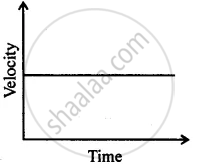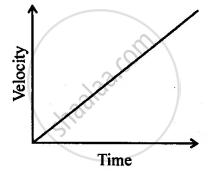Advertisements
Advertisements
Question
A bus increases its speed from 36 km/h to 72 km/h in 10 seconds. Its acceleration is :
Options
5 m/s2
2 m/s2
3.6 m/s2
1 m/s2
Solution
1 m/s2
Final velocity is = 72 km/h = 20 m/s
Initial velocity is = 36 km/h = 10 m/s
Time taken is 10 sec. so,
Acceleration = `(20-10)/10`
= 1 m/s2
So, the answer is
(d) 1 m/s2
APPEARS IN
RELATED QUESTIONS
A train starting from a railway station and moving with uniform acceleration attains a speed 40 km h−1 in 10 minutes. Find its acceleration.
Fill in the following blank with suitable word :
A motorcycle has a steady……………. of 3 m/s2. This means that every………………. its…………….. increases by………….
Name the quantity which is measured by the area occupied under the velocity-time graph.
Describe the motion of a body which is accelerating at a constant rate of 10 m s–2. If the body starts from rest, how much distance will it cover in 2 s ?
A cheetah starts from, rest, and accelerates at 2 m/s2 for 10 seconds. Calculate :
(a) the final velocity
(b) the distance travelled.
Derive the formula : v = u + at, where the symbols have usual meanings.
Can you suggest a real-life example about the motion of a body from the following velocity – time graph?

Can you suggest a real-life example about the motion of a body from the following velocity – time graph?

A body is thrown vertically upward with velocity u, the greatest height h to which it will rise is,
An electron moving with a velocity of 5 × 104 ms−1 enters into a uniform electric field and acquires a uniform acceleration of 104 ms–2 in the direction of its initial motion.
(i) Calculate the time in which the electron would acquire a velocity double of its initial velocity.
(ii) How much distance the electron would cover at this time?
